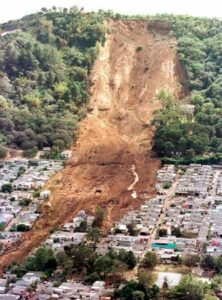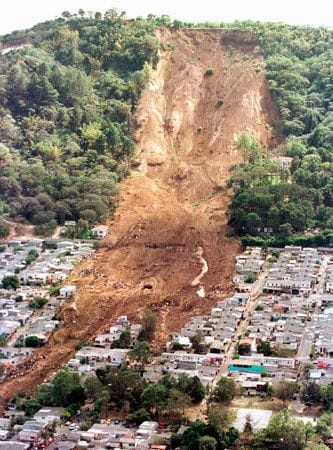 A landslide is a dramatic event where rock, earth, or debris suddenly descends a slope due to gravity, often resulting in significant destruction. This phenomenon occurs when the stability of a slope is compromised, typically by factors such as heavy rainfall, earthquakes, or volcanic activity. Intense or prolonged rain can saturate soil, making it heavy and unstable, while seismic activity can shake and destabilize slopes. Human activities like deforestation, construction, and mining further exacerbate the risk by weakening the land’s stability. Landslides can manifest in various forms, including sudden rockfalls, fast-moving mudslides, rotational slumps, or gradual soil creep. The impacts are severe, often burying homes, damaging infrastructure, and leading to loss of life. The environmental consequences are equally grave, disrupting ecosystems and causing long-term harm. Mitigation efforts, such as constructing retaining walls, improving drainage systems, and engaging in land use planning, are crucial for reducing landslide risks. Additionally, reforestation can help stabilize soil and prevent erosion. Understanding and managing these risks are essential to protect communities and minimize the devastating effects of landslides.
A landslide is a dramatic event where rock, earth, or debris suddenly descends a slope due to gravity, often resulting in significant destruction. This phenomenon occurs when the stability of a slope is compromised, typically by factors such as heavy rainfall, earthquakes, or volcanic activity. Intense or prolonged rain can saturate soil, making it heavy and unstable, while seismic activity can shake and destabilize slopes. Human activities like deforestation, construction, and mining further exacerbate the risk by weakening the land’s stability. Landslides can manifest in various forms, including sudden rockfalls, fast-moving mudslides, rotational slumps, or gradual soil creep. The impacts are severe, often burying homes, damaging infrastructure, and leading to loss of life. The environmental consequences are equally grave, disrupting ecosystems and causing long-term harm. Mitigation efforts, such as constructing retaining walls, improving drainage systems, and engaging in land use planning, are crucial for reducing landslide risks. Additionally, reforestation can help stabilize soil and prevent erosion. Understanding and managing these risks are essential to protect communities and minimize the devastating effects of landslides.

WHAT IS LANDSLIDE?
Written by admin
Published on: